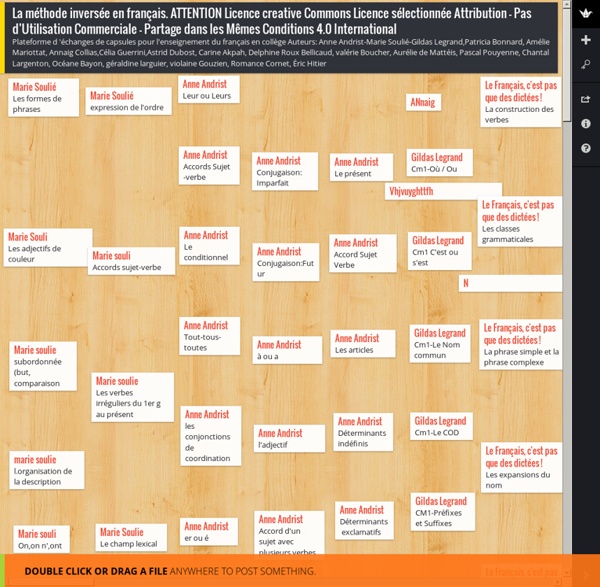



http://padlet.com/marie34/methodeinversee
Related: Classe inversée • Français & Lettres • CLASSE INVERSEE • langue francaise10 Teacher-Tested Tools for Flipping Your Classroom - Getting Smart by Susan Lucille Davis - blended learning, digital learning, education technology, flipclass, flipped class, flipped classroom, Online Learning, Teaching, the flipped classroom For the past couple of weeks, I’ve spent some time addressing my earlier commitments to flipping at least some portion of my Language Arts classes. (You can learn about my ongoing saga at “4 Ways Flipping Forces Fundamental Change” and at “Why I Haven’t Flipped…Yet”). Reading FlipYour Classroom by Jonathan Bergmann and Aaron Sams provided practical advice and a justification for flipping, Learning about the Stanford studies that suggest better results from flipping your flipping (that is, doing hands-on work in the classroom first, reinforced by flipped lessons at night) But, ultimately, what I needed to do was to dive in and try out some tools with my kids and my curriculum in mind. The unexpected result: I’ve had to acknowledge something I hadn’t really thought about — I am a video-phobe. C’mon, Everyone, Let’s Flip
Promoting Strong Writing Skills in Middle and High School With Digital Instruction Writing is a crucial skill for learners, for their academic careers and their life after school. In our current situation, teachers need strategies for writing instruction that can be used in both face-to-face and virtual settings, because even at schools that have reopened for in-person learning, there’s a chance we’ll have to shift back to distance learning if local coronavirus cases surge. I have a technique that teachers across content areas and grade levels can implement in their classes to enhance their writing instruction. Digital writing conferences provide students with written feedback on their writing. Unlike verbal feedback during face-to-face conferences, which many of us are familiar with, students will always have access to the feedback—they won’t forget what they have been told and can refer to the feedback for future growth.
A Step by Step Tutorial on How to Flip your Classroom with TED Ed Below is a visual guide to walk you through the process of how to created a flipped lesson using TED Ed website. First head over to TED ED and :1- Click on " Find and Flip " 2- Find YouTube Videos for your lessons You can search YouTube for a video to build a lesson around. This video will be the centerpiece of your lesson. 3- Click to select that video then click on " Flip this video " 4- Listed /Unlisted Now you can choose whether you want your flipped lesson to be discovered by TED community or not simply by clicking on Listed/Unlisted button.
Thank you for subscribing! We’re so glad that you’re becoming a more engaged member of the Flipped Learning Network community! We’re all about sharing resources and research, tips and tools, and learning from each other. If you would like to consider writing a piece for us to post here, or sharing content you’ve already written, just reach out using the Contact Form. In the meanwhile, please enjoy the growing body of content here on the site, including: Getting Started and How To posts YouTube Channels or Playlists with good flipped and blended learning content, created by teachers, and channels and playlists focused on techniques and tools for flipped learningAcademic Subject specific contentRemember, we’re on Facebook and Twitter ()! We hope you will Like Us and Follow Us!
10 Free Resources for Flipping Your Classroom Thanks to the folks over at Khan Academy, alternative modes of delivering classroom instruction are all the rage. We’ve got face to face models, labs, rotations, online-only, self-blend, and of course, flipped. While there are numerous ways to implement a flipped classroom, the basic components include some form of prerecorded lectures that are then followed by in-class work. Flipped classrooms are heralded for many reasons.
Using ‘Hexagonal Thinking’ to Deepen Classroom Conversations Online and in person, hexagonal thinking can be a fresh way to boost the energy level in classroom discussions. “Your students will see things in new ways as they seek to connect wide-ranging ideas,” writes English teacher Betsy Potash for Cult of Pedagogy. With many students learning from home this school year, it’s a strategy that can help get kids back into a “critical thinking zone.” The Best Posts On The “Flipped Classroom” Idea Check out my two-part Education Week Teacher series on the flipped classroom here I’m a bit wary/skeptical about whole “Flipped Classroom” idea and how it works in practice. Diana Laufenberg spoke for me, also, in some of her tweets about the concept: But I’m still open to learning, and I invite your suggestions for additions to list. In the meantime, though, here are some posts that some of my questions more eloquently than I could: The Flipped Classroom: Pro and Con is by Mary Beth Hertz and appeared in Edutopia.
WANTED: The 10 Classrooms That Can’t Be Flipped – Flipped Learning Global Initiative Try this… Stand up in front a group of educators and say, “Flipped Learning is the meta-strategy that that supports all other instructional models.”